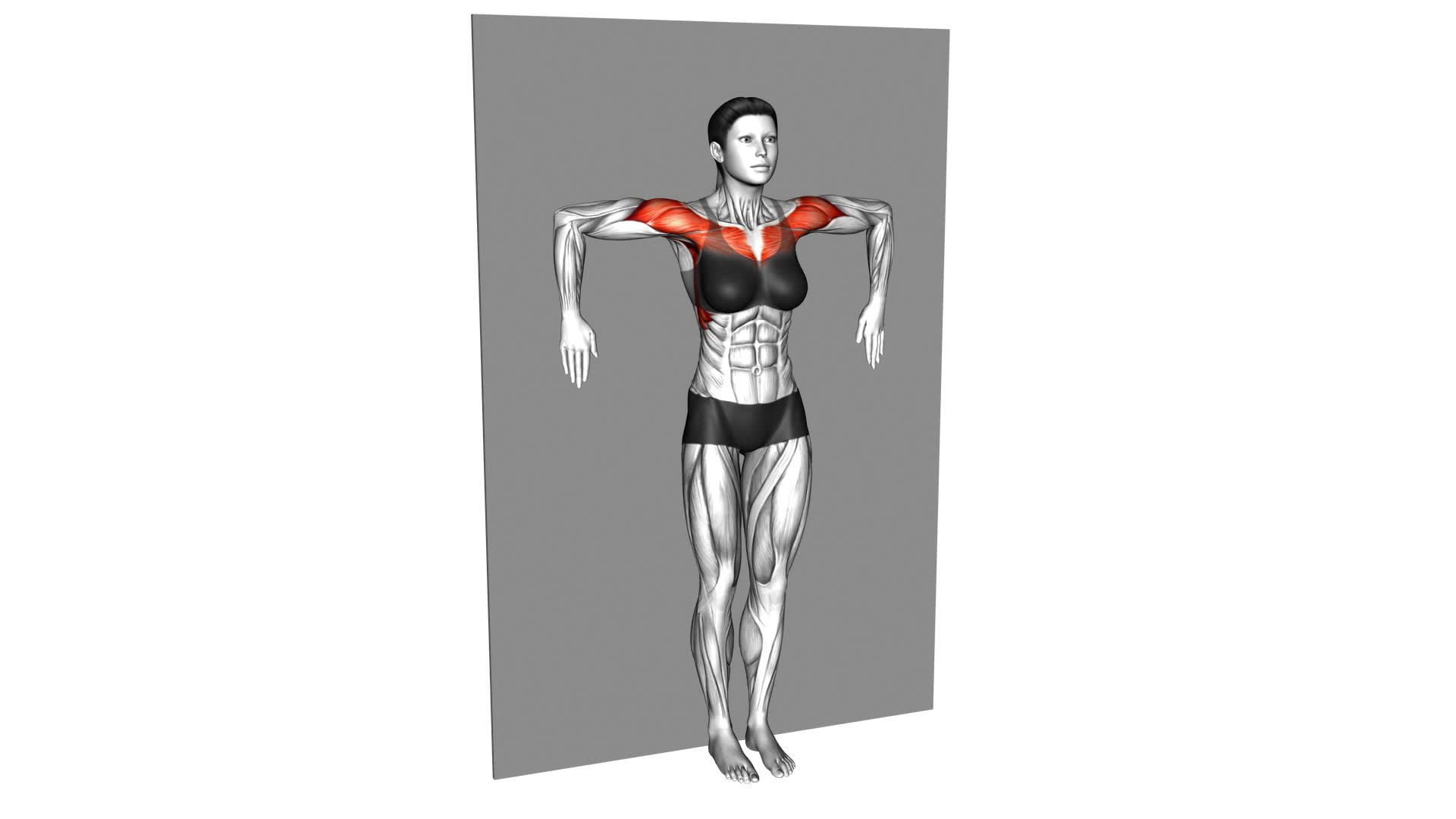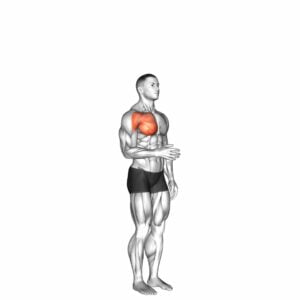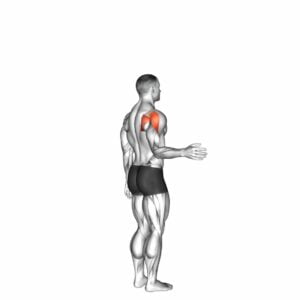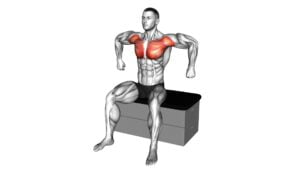Internal and External Shoulder Rotation Against Wall (Female) – Video Exercise Guide & Tips

In this video exercise guide, you'll learn how to perform internal and external shoulder rotation against a wall.
Watch This Exercise Video
This exercise is specifically designed for females and can help improve shoulder mobility and strength.
By following the step-by-step instructions and tips provided, you'll be able to properly align yourself and maximize the effectiveness of this exercise.
Get ready to take your shoulder workout to the next level!
Key Takeaways
- Shoulder rotation exercises enhance mobility and strengthen rotator cuff muscles.
- Proper alignment and setup are important for this exercise, including keeping the head, upper back, and buttocks in contact with the wall.
- Beginners can modify the exercise by starting with a smaller range of motion and using lighter weights or no weights at all.
- Advanced variations of the exercise include increasing resistance, modifying body position, and incorporating instability using a stability ball or BOSU ball.
Benefits of Shoulder Rotation Exercises
You can enhance your shoulder mobility and strengthen the rotator cuff muscles by incorporating shoulder rotation exercises into your fitness routine. Shoulder rotation exercises offer numerous benefits, including improved range of motion, increased strength, and injury prevention. By regularly performing these exercises, you can target the muscles surrounding the shoulder joint, enhancing their flexibility and stability.
One of the key benefits of shoulder rotation exercises is the improvement in range of motion. These exercises specifically target the shoulder joint, allowing it to move through its full range of motion. This increased mobility can be particularly beneficial for athletes or individuals involved in activities that require overhead movements, such as swimming or throwing.
In addition to range of motion, shoulder rotation exercises also help to strengthen the rotator cuff muscles. These muscles play a crucial role in stabilizing the shoulder joint and preventing injuries. By regularly performing shoulder rotation exercises, you can strengthen these muscles, improving their ability to support the shoulder joint during various movements.
To maximize the effectiveness of shoulder rotation exercises, it's important to maintain proper form and technique. Start with lighter weights or resistance bands and gradually increase the intensity as your strength improves. Focus on controlled and smooth movements, avoiding any jerking or swinging motions. It's also important to listen to your body and stop if you experience pain or discomfort.
With an understanding of the benefits and tips for maximizing the effectiveness of shoulder rotation exercises, let's now turn our attention to the equipment needed for shoulder rotation against a wall.
Equipment Needed for Shoulder Rotation Against Wall
To perform shoulder rotation against a wall, you'll need a stability ball and a resistance band. These pieces of equipment are essential for targeting and strengthening the muscles involved in shoulder rotation. The stability ball provides an unstable surface, which engages the core muscles and enhances the effectiveness of the exercise. It also helps to improve balance and stability.
The resistance band is used to add resistance to the movement, making the exercise more challenging and promoting muscle growth and strength. It can be adjusted to different levels of resistance to accommodate varying fitness levels and goals.
In addition to the stability ball and resistance band, there are other equipment options available for shoulder rotation variations. Dumbbells or kettlebells can be used as an alternative to the resistance band, providing a different type of resistance and allowing for a wider range of motion. Additionally, a wall or doorway can be used instead of a stability ball, although it may not provide the same level of instability and core engagement.
Proper Alignment and Setup for the Exercise
For proper alignment and setup of the exercise, it's important to ensure that your body is positioned correctly against the wall. Follow these alignment tips to ensure proper execution of the internal and external shoulder rotation against the wall exercise:
- Stand with your feet hip-width apart and your back flat against the wall.
- Keep your head, upper back, and buttocks in contact with the wall throughout the exercise.
- Engage your core muscles by drawing your belly button towards your spine.
- Relax your shoulders and avoid shrugging them towards your ears.
- Maintain a neutral spine by avoiding excessive arching or rounding.
Modifications for beginners:
- If you're new to this exercise, start with a smaller range of motion until you feel comfortable and confident.
- Use a softer surface, such as a foam roller or cushion, behind your back to provide additional support.
- Begin with lighter weights or no weights at all, focusing on mastering the correct form and technique before progressing to heavier loads.
Step-by-Step Guide for Internal Shoulder Rotation
To effectively perform internal shoulder rotation against a wall, it's important to understand the muscle engagement involved.
This exercise primarily targets the internal rotators of the shoulder, such as the subscapularis muscle.
It's crucial to maintain proper form and avoid common mistakes, such as excessive shoulder shrugging or using momentum to initiate the movement.
As you progress in your training, you can incorporate advanced variations, such as using resistance bands or weights, to further challenge and strengthen the internal rotators of the shoulder.
Muscle Engagement During Rotation
Engage the muscles involved in internal shoulder rotation by following this step-by-step guide. Internal shoulder rotation is an important movement that helps strengthen the muscles around the shoulder joint, promoting stability and reducing the risk of injury. To maximize muscle activation during this exercise, focus on the following:
- Stand against a wall with your feet shoulder-width apart.
- Place your hands on the wall at shoulder height, with your elbows bent at a 90-degree angle.
- Keep your core engaged and your spine in a neutral position.
- Rotate your shoulders inward, trying to touch your forearms together without moving your hands off the wall.
- Hold this position for a few seconds, then slowly return to the starting position.
By actively engaging these muscles, you can enhance muscle activation and ensure proper form during internal shoulder rotation.
Now, let's explore the common mistakes to avoid to further optimize your exercise routine.
Common Mistakes to Avoid
To optimize your internal shoulder rotation exercise, it's important to avoid these common mistakes.
First, make sure you aren't arching your back or leaning forward during the movement. This can put unnecessary strain on your lower back and compromise the effectiveness of the exercise. Instead, maintain a neutral spine and engage your core for stability.
Another common mistake is using too much momentum to rotate your shoulders. Focus on controlled movements and avoid swinging your arms.
Additionally, be mindful of your shoulder positioning. Avoid shrugging or hunching your shoulders, as this can lead to tension and poor alignment.
Lastly, remember to breathe throughout the exercise to maintain relaxation and avoid unnecessary tension.
Progression and Advanced Variations
How can you further challenge yourself with the internal shoulder rotation exercise?
To progress and advance the exercise, you can incorporate various variations and modifications. Here are some options to consider:
- Increase the resistance: Use resistance bands or dumbbells to add extra weight and intensify the exercise.
- Modify the body position: Instead of standing against the wall, try performing the internal shoulder rotation exercise in a seated or kneeling position.
- Change the range of motion: Gradually increase the range of motion by moving your arms further away from your body while maintaining proper form.
- Perform single-arm rotations: Instead of using both arms simultaneously, focus on one arm at a time to engage the shoulder muscles more intensely.
- Incorporate instability: Use a stability ball or a BOSU ball to challenge your balance and stability while performing the exercise.
Step-by-Step Guide for External Shoulder Rotation
Stand with your back against a wall for the external shoulder rotation exercise. This exercise targets the muscles in your shoulders, particularly the rotator cuff muscles.
To begin, position yourself standing with your feet shoulder-width apart and your back pressed firmly against the wall. Bend your elbows to 90 degrees, with your forearms parallel to the floor. Keep your upper arms against the wall throughout the exercise.
Begin by externally rotating your shoulders, moving your forearms away from the wall while maintaining the 90-degree angle at your elbows. Pause briefly at the end of the movement, feeling the contraction in your shoulders. Slowly return to the starting position, bringing your forearms back to the wall.
Repeat this movement for the recommended number of repetitions. The external shoulder rotation exercise helps strengthen and stabilize the muscles surrounding the shoulder joint, which can improve overall shoulder function. It can also help prevent shoulder injuries and improve posture.
To modify this exercise, you can use a resistance band or dumbbells to add resistance. Start with lighter weights and gradually increase as you become stronger.
Tips for Maximizing the Effectiveness of the Exercise
To maximize the effectiveness of the internal and external shoulder rotation against the wall exercise, it's crucial to focus on proper form and technique.
Ensure that your shoulders are properly aligned and your back is straight against the wall.
Additionally, remember to engage your core and breathe deeply throughout the exercise to maintain stability and optimize muscle activation.
Proper Form and Technique
To maximize the effectiveness of the exercise, ensure that you maintain proper form and technique while performing internal and external shoulder rotation against the wall. Proper form and technique are crucial for shoulder mobility and injury prevention. Here are some tips to help you maintain correct form:
- Stand with your back against the wall, ensuring your feet are shoulder-width apart.
- Keep your back and head straight throughout the exercise.
- Engage your core muscles to stabilize your body.
- Start with your arms bent at a 90-degree angle, elbows tucked in by your sides.
- Slowly rotate your arms outward and then inward, maintaining control and avoiding any jerky movements.
Maintaining proper form and technique won't only enhance the effectiveness of the exercise but also reduce the risk of injury.
Now, let's move on to the next section about breathing and core engagement.
Breathing and Core Engagement
Maintaining proper form and technique while performing internal and external shoulder rotation against the wall is important for an effective exercise. Focusing on your breathing and engaging your core muscles can further enhance the benefits of this exercise.
Proper breathing techniques are essential during this exercise. Inhale deeply through your nose as you rotate your shoulders, expanding your diaphragm and filling your lungs with air. This helps stabilize your body and maintain control. Exhale slowly and fully through your mouth as you rotate back to the starting position. This controlled breathing pattern not only helps you stay focused but also engages your core muscles.
Core activation is crucial for stability and balance. Throughout the exercise, be sure to engage your abdominal muscles by gently pulling your belly button towards your spine. This will help engage your core muscles and provide stability.
Frequently Asked Questions
How Long Should I Hold Each Position During the Shoulder Rotation Exercise?
When performing the shoulder rotation exercise, it's important to focus on the proper form to maximize the benefits.
As for how long you should hold each position, it's recommended to hold each rotation for about 10-15 seconds. This allows enough time for the muscles to engage and stretch.
Remember to maintain proper alignment and control throughout the exercise to avoid injury and get the most out of your shoulder rotation routine.
Can Shoulder Rotation Exercises Help Improve Posture?
Shoulder rotation exercises are a great way to improve your posture. By targeting the muscles in your shoulders, these exercises can help strengthen and stabilize the surrounding structures, leading to better alignment and posture.
Beginners can start with simple shoulder rotations against a wall, gradually increasing the range of motion and resistance over time.
The benefits of shoulder rotation exercises extend beyond posture improvement, including increased shoulder mobility, reduced risk of shoulder injuries, and improved overall upper body strength.
Are There Any Modifications or Variations of the Exercise for Individuals With Shoulder Injuries?
Modifications to the exercise can be made for those with shoulder injuries. These modifications can help reduce strain on the injured shoulder while still reaping the benefits of the exercise. By adjusting the range of motion or using lighter weights, individuals with shoulder injuries can still engage the muscles involved in internal and external shoulder rotation without exacerbating their injury.
It's important to consult with a healthcare professional or physical therapist for specific modifications based on the type and severity of the shoulder injury.
How Often Should I Perform Shoulder Rotation Exercises for Optimal Results?
To achieve optimal results with shoulder rotation exercises, it's important to consider the frequency and duration of the exercise.
The shoulder rotation exercise frequency refers to how often you should perform the exercise. This can vary depending on your specific goals and fitness level. Consulting with a professional can help you determine the appropriate frequency for you.
The shoulder rotation exercise duration refers to the length of time you should engage in the exercise during each session. Again, this can vary based on your goals and fitness level. It's important to find a duration that challenges you but also allows for proper form and technique.
Can Shoulder Rotation Exercises Help Prevent Shoulder Injuries in Sports or Other Physical Activities?
Shoulder rotation exercises are essential for preventing shoulder injuries in sports or physical activities. These exercises help to strengthen the muscles surrounding the shoulder joint, improving stability and flexibility.
Conclusion
In conclusion, internal and external shoulder rotation exercises against a wall can provide numerous benefits, including improved shoulder strength, flexibility, and stability.
By following the proper alignment and setup, along with the step-by-step guides for each rotation, individuals can effectively target and strengthen the muscles involved in shoulder movement.
Additionally, incorporating these exercises into a regular fitness routine can help maximize their effectiveness and contribute to overall shoulder health.

Author
Years ago, the spark of my life’s passion ignited in my mind the moment I stepped into the local gym for the first time. The inaugural bead of perspiration, the initial endeavor, the very first surge of endorphins, and a sense of pride that washed over me post-workout marked the beginning of my deep-seated interest in strength sports, fitness, and sports nutrition. This very curiosity blossomed rapidly into a profound fascination, propelling me to earn a Master’s degree in Physical Education from the Academy of Physical Education in Krakow, followed by a Sports Manager diploma from the Jagiellonian University. My journey of growth led me to gain more specialized qualifications, such as being a certified personal trainer with a focus on sports dietetics, a lifeguard, and an instructor for wellness and corrective gymnastics. Theoretical knowledge paired seamlessly with practical experience, reinforcing my belief that the transformation of individuals under my guidance was also a reflection of my personal growth. This belief holds true even today. Each day, I strive to push the boundaries and explore new realms. These realms gently elevate me to greater heights. The unique combination of passion for my field and the continuous quest for growth fuels my drive to break new ground.







